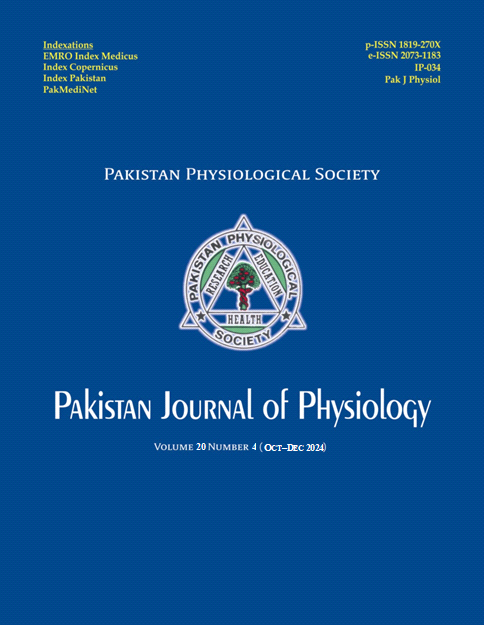NOVEL HETEROZYGOUS PSMB8 MUTATION IN CANDLE SYNDROME: FIRST REPORT OF ASSOCIATED LOW NK CELL LEVELS
DOI:
https://doi.org/10.69656/pjp.v20i4.1769Keywords:
DNA Sanger sequencing, PSMB8, Flow cytometery, NK-cells, CANDLE syndromeAbstract
Background: Chronic atypical neutrophilic dermatosis with lipodystrophy and elevated temperature (CANDLE) syndrome is a rare auto-inflammatory inherited type of condition classified in the past few years. The clinical manifestations are observed during the first year of life. Inherited mutations in the PSMB8 gene are reported to cause CANDLE syndrome. Methods: Detailed family and clinical histories were obtained. Genomic DNA was extracted from the whole blood. DNA Sanger sequencing was performed to identify disease-causing mutations in the gene PSMB8 (Proteasome subunit beta type-8). Complete Blood Count (CBC), Liver Function Test (LFT), blood culture, contrast tomography scan (CT) and ultrasound scrotum were performed. An expert dermatologist investigated nodular erythema or erythematous eruptions. Results: DNA Sanger sequencing revealed a heterozygous missense mutation in gene PSMB8 (c.599C>T). The patient's mother was homozygous for the missense mutation. High-grade episodic fever with low-fat levels (possibly lipodystrophy) was observed in body areas. Blood CBC revealed neutrophilia while the CT scan showed post-infective consolidation in the upper lobe of the posterior segment. Conclusion: The current study describes a novel heterozygous genetic mutation. Clinical investigations revealed disease features partially fulfilling the criteria. We also report here for the first time CANDLE syndrome with low levels of natural killer cells (NK cells).
Pak J Physiol 2024;20(4):28-31, DOI: https://doi.org/10.69656/pjp.v20i4.1769
Downloads
References
de Jesus AA, Brehm A, Van Tries R, Pillet P, Parentelli AS, Montealegre Sanchez GA, et al. Novel proteasome assembly chaperone mutations in PSMG2/PAC2 cause the autoinflammatory interferonopathy CANDLE/PRAAS4. J Allergy Clin Immunol 2019;143:1939–43.
Yu Q, Mehta A, Zou J, Beers J, de Jesus Rasheed AA, Goldbach-Mansky R, et al. Human induced pluripotent stem cells generated from chronic atypical neutrophilic dermatosis with lipodystrophy and elevated temperature (CANDLE) syndrome patients with a homozygous mutation in the PSMB8 gene (NIHTVBi016-A, NIHTVBi017-A, NIHTVBi018-A). Stem Cell Res 2022;62:102820.
Brehm A, Liu Y, Sheikh A, Marrero B, Omoyinmi E, Zhou Q, et al. Additive loss-of-function proteasome subunit mutations in CANDLE/PRAAS patients promote type I IFN production. J Clin Invist 2016;126(2):795.
de Jesus AA, Hou Y, Brooks S, Malle L, Biancotto A, Huang Y, et al. Distinct interferon signatures and cytokine patterns define additional systemic autoinflammatory diseases. J Clin Invest 2020;130:1669–82.
Liu Y, Ramot Y, Torrelo A, Paller AS, Si N, Babay S, et al. Mutations in PSMB8 cause CANDLE syndrome with evidence of genetic and phenotypic heterogeneity. Arthritis Rheum 2012;64(3):895–907.
Torrelo A. CANDLE Syndrome. In: Rezael N. (Ed) Genetic Syndromes: A Comprehensive Reference Guide. Springer; 2020.
Tipu HN, Raza R, Jaffar S, Khan A, Anwar MZ, Ahmad W, et al. ?2 Integrin Gene (ITGB2) mutation spectra in Pakistani families with leukocyte adhesion deficiency type 1 (LAD1). Immunbiol 2020;225(3):151938.
Torrelo A, Patel S, Colmenero I, Gurbindo D, Lendínez F, Hernández A, et al. Chronic atypical neutrophilic dermatosis with lipodystrophy and elevated temperature (CANDLE) syndrome. J Am Acad Dermatol 2010;62(3):489–95.
Downloads
Published
How to Cite
Issue
Section
License

This work is licensed under a Creative Commons Attribution-NoDerivatives 4.0 International License.
The author(s) retain the copyrights and allow their publication in Pakistan Journal of Physiology, Pak J Physiol, PJP to be FREE for research and academic purposes. It can be downloaded and stored, printed, presented, projected, cited and quoted with full reference of, and acknowledgement to the author(s) and the PJP. The contents are published with an international CC-BY-ND-4.0 License.












